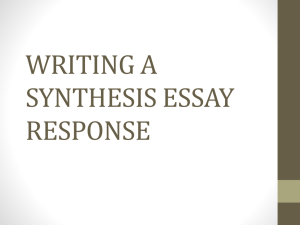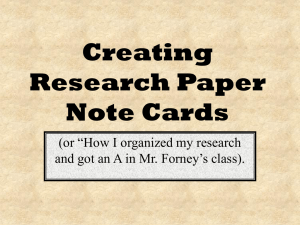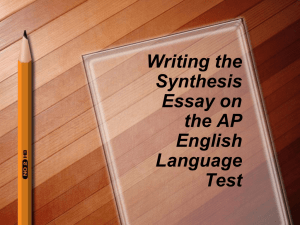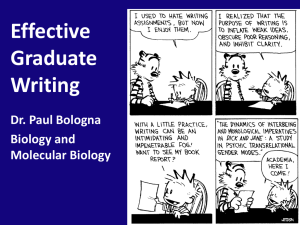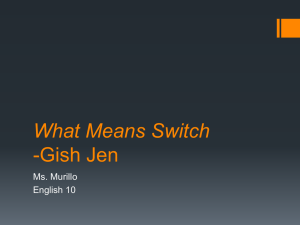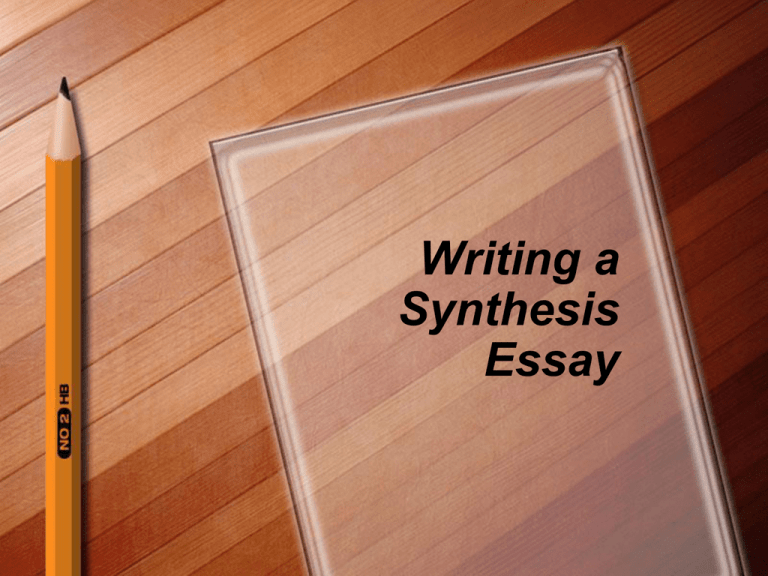
Writing a
Synthesis
Essay
Drew University On-Line Resources for
Writers “Key Features of a Synthesis”
It accurately reports
information from the
sources using different
phrases and sentences;
Drew University On-Line Resources for
Writers “Key Features of a Synthesis”
It is organized in such a way
that readers can
immediately see where
the information from the
sources overlap;
Drew University On-Line Resources for
Writers “Key Features of a Synthesis”
It makes sense of the
sources and helps the
reader understand them
in greater depth.
Definition of the form
First,
the writer is asked to
take a position on a given
issue, using multiple sources.
(the key word here is
multiple)
Definition of the form
Writer
makes
connections
with sources
and personal
observations
to support
his/her stand
on the issue.
How is it done?
Writer
Clearly promotes an idea,
Understands how to use a variety of
sources including non-print text
(pictures, graphs, etc.),
Uses this “synthesis” to support that
idea.
How is it done?
Writer
Uses quotes or phrases to
extract key information.
Demonstrates understanding
in using the quotes or
phrases.
How is it done?
Writer
Uses the quotes to support
his/her opinion/position.
Uses MLA citation because a
writer NEVER wants to
plagiarize.
Remember!
Synthesis
is not merely
incorporating sources.
How is it done?
Think of it as if
you are a
chef creating
a new recipe
using the
sources as
some of the
ingredients.
Remember!
Synthesis
is
combining information
from other sources
with your opinion!
So, how do I do it?
Essay
must be thesis
driven, so form a thesis
based on the prompt.
What you plan to argue
+ How you plan to argue it
= Thesis
Use your
prewriting
time to jot
down
ideas that
support
your
thesis.
So, how do I do it?
Highlight
information in the
sources that support your
thesis so you can find them
later. (Remember annotating
text? Mark it up! Make
comments as you read!)
So, how do I do it?
Draw on 3 or more sources.
Use different phrases and sentences
to support a central idea - use these
as your quotes.
Only 1 text
-- baaad!
3 or more
texts -goood!
So, how do I do it?
Make connections among the sources make sense of the sources so the
reader has better understanding.
So, how do I do it?
Make further
connections
through
personal
observations
and/or theories
that relate to the
information from
the sources.
Think of your connections as limbs and
branches on a tree.
Think of your connections as
branches on a tree.
Each
limb grows from the
trunk, so each connection
grows from your topic or
thesis.
Branches grow from limbs =
ideas connected to that
connection.
Leaves = details
Approaches to
Writing the
Synthesis
Essay
#1: Thesis Supported by
Examples
Base your thesis
on common
points among the
works.
Support your
thesis with
appropriate
examples from
the works.
Thesis Supported by
Examples
Answer
the question, “What
information must we know in
order to understand the
topic, and why?
Thesis Supported by
Examples
This
strategy is best with
essays that approach the
subject with very diverse
viewpoints.
Thesis Supported by
Examples
Warning!
Can
seem more like a
report than an argument,
so try not to make it sound
like a report and not an
essay.
#2: Compare and Contrast
Discuss
similarities and
differences in
the sources’
viewpoints.
Draw a
conclusion from
this comparison.
Argument: The Most Important
Element!
You
MUST have a
clearly defined opinion
on the subject!
Argument: The Most Important
Element!
Support your opinion with valid
viewpoints of your sources.
Argument: The Most Important
Element!
Analyze
weaknesses of any
ideas you feel are not valid.
–Identify conflicting ideas.
–Overcome opposing
viewpoints!
Remember!
Keep
in mind that your
goal is to support and
illustrate your own ideas
with the ideas of others to
make a point.
The Introduction should
help your readers
make a transition
between their own
world and the issues
you will be writing
about;
give your readers the
tools they need to
get into your topic
and care about what
you are saying.
Format - The Introduction
Usually one paragraph
Contains a one-sentence
statement (thesis) that sums up
the focus of the essay.
What you plan to argue
+ How you plan to argue
it
= Thesis
Format - The Introduction
Clues reader about major points, how
you will prove your thesis
Also can, but does not always:
– Introduce the sources, give titles, using
MLA citation.
– Provides names of authors,
– Sometimes provides pertinent background
about the authors, texts, or general topic.
Note: This form of introduction can be dry and
sound too much like a report, but is sometimes
required in certain forms of writing.
Format - The Body
Organized by theme, point, similarity,
or aspect of the topic.
Each paragraph deals with one
specific point/idea that relates to the
thesis.
Format - Paragraphs
Begins
with
a topic
sentence let the
reader know
what the
paragraph is
about.
Format - Paragraphs
Includes
information
from more than
one source.
Format - Paragraphs
Indicates where information comes from with
either lead in phrases and verbs of
attribution
– According to _______
– _______ states
– _______ affirms
– _______ explains
OR with MLA citation (use parenthetical).
Format - Paragraphs
Shows the similarities or differences
between the different sources in
ways that make the paper
informative.
Format - Paragraphs
Represents the texts fairly -even if that seems to weaken
your paper!
Avoid relying on one source and
just filling in others to meet the
required number of sources.
Format - the Conclusion
Remind readers of the most
significant themes and how they
connect to the overall topic.
Go beyond a mere summary -- offer
the reader insight into the
significance of the exploration of the
topic.
Format - The Conclusion
Your conclusion provides a
bridge to help your
readers transition back
to their daily lives. A
conclusion helps them
see why all your
analysis and information
should matter to them
after they put the paper
down.
A Word About Plagiarism
Be certain to properly cite your
sources!
Go back over your paper and make
certain you have properly cited all
sources.
You can
– Use verbs of attribution
– Use parenthetical citations
A Word About Plagiarism
Accidental
plagiarism most
often occurs when
writers are
synthesizing
sources and do
not indicate where
the synthesis ends
and their own
comments begin!
A Word About Plagiarism
There are many resources
available to students to check for
plagiarism. A good starting
place for understanding what it
is: http://www.plagiarism.org/
Don’t let this happen!
(Cartoon copyright 2001 Pyrczak Publishing. All rights reserved.)
A Word About Plagiarism
A national survey
published in Education
Week found that
54% of students admitted
to plagiarizing from the
internet;
http://mwcclibrary.blogspot.com/2008_07_01_archive.html
Jeffrey, what you did is called plagiarism not cloning."
A Word About Plagiarism
A national survey published in
Education Week found that
74% of students admitted
that at least once during the
past school year they had
engaged in "serious"
cheating.
(http://www.plagiarism.org/plag_facts.html)
Plagiarism – Why Take A
Chance?
http://turnitin
.com/is
widely used
in high
schools,
college, and
universities.
A Word About Plagiarism
There is even a special version
of turnitin for colleges to check
admission essays:
http://www.turnitinadmissions.co
m/
A Word About Avoiding
Plagiarism
There are many free plagiarism
checkers available on-line. I
have had success with
http://www.duplichecker.com/
There is now a student version
of turnitin.com called WriteCheck
available for a fee.
That is how
you write a
synthesis
essay!


